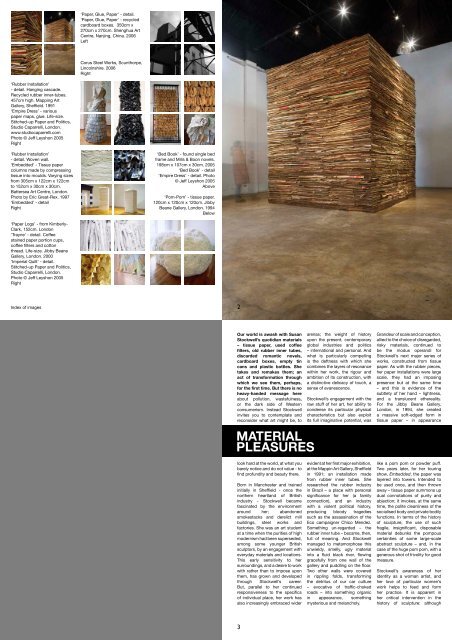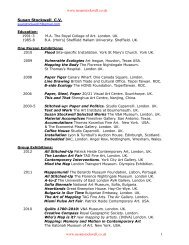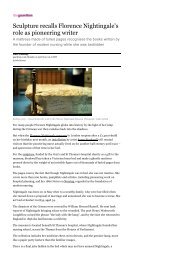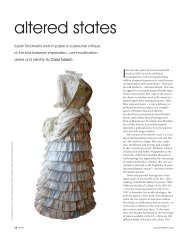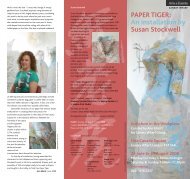‘Paper, Glue, Paper’ - detail.‘Paper, Glue, Paper’ - recycledcardboard boxes. 350cm x270cm x 270cm. Shenghua ArtCentre, Nanjing, China. 2006LeftCorus Steel Works, Scunthorpe,Lincolnshire. 2006Right‘Rubber Installation’- detail. Hanging cascade.Recycled rubber inner-tubes.457cm high. Mapping ArtGallery, Sheffield. 1991‘Empire Dress’ - variouspaper maps, glue. Life-size.Stitched-up Paper and Politics,Studio Caparrelli, London.www.studiocaparrelli.comPhoto © Jeff Leyshon 2005Right‘Rubber Installation’- detail. Woven wall.‘Embedded’ - Tissue papercolumns made by compressingtissue into moulds. Varying sizesfrom 305cm x 122cm x 122cmto 152cm x 30cm x 30cm.Battersea Art Centre, London.Photo by Eric Great-Rex. 1997‘Embedded’ - detailRight‘Bed Book’ - found single bedframe and Mills & Boon novels.198cm x 107cm x 30cm. 2005‘Bed Book’ - detail‘Empire Dress’ - detail. Photo© Jeff Leyshon 2005Above‘Pom-Pom’ - tissue paper.120cm x 120cm x 120cm. JibbyBeane Gallery, London. 1994Below‘Paper Logs’ - from Kimberly-Clark, 152cm. London‘Trayne’ - detail. Coffeestained paper portion cups,coffee filters and cottonthread. Life-size. Jibby BeaneGallery, London. 2000‘Imperial Quilt’ - detail.Stitched-up Paper and Politics,Studio Caparrelli, London.Photo © Jeff Leyshon 2005RightIndex of images2Our world is awash with <strong>Susan</strong><strong>Stockwell</strong>’s quotidian materials– tissue paper, used coffeefilters, old rubber inner tubes,discarded romantic novels,cardboard boxes, empty tincans and plastic bottles. Shetakes and remakes them; anact of transformation throughwhich we see them, perhaps,for the first time. But there is noheavy-handed message hereabout pollution, wastefulness,or the dark side of Westernconsumerism. Instead <strong>Stockwell</strong>invites you to contemplate andreconsider what art might be, toMATERIALPLEASURESarenas; the weight of historyupon the present, contemporaryglobal industries and politics– international and personal. Andwhat is particularly compellingis the deftness with which shecombines the layers of resonancewithin her work, the rigour andambition of its construction, witha distinctive delicacy of touch, asense of evanescence.<strong>Stockwell</strong>’s engagement with theraw stuff of her art, her ability tocondense its particular physicalcharacteristics but also exploitits full imaginative potential, wasGrandeur of scale and conception,allied to the choice of disregarded,risky materials, continued tobe the modus operandi for<strong>Stockwell</strong>’s next major series ofworks, constructed from tissuepaper. As with the rubber pieces,her paper installations were largescale, they had an imposingpresence but at the same time– and this is evidence of thesubtlety of her hand – lightness,and a translucent ethereality.For the Jibby Beane Gallery,London, in 1994, she createda massive soft-edged form intissue paper – in appearancelook hard at the world, at what youbarely notice and do not value - tofind profundity and beauty there.Born in Manchester and trainedinitially in Sheffield - once thenorthern heartland of Britishindustry - <strong>Stockwell</strong> becamefascinated by the environmentaround her; abandonedsmokestacks and derelict millbuildings, steel works andfactories. She was an art studentat a time when the purities of highmodernism had been superseded,among some younger Britishsculptors, by an engagement witheveryday materials and locations.This early sensitivity to hersurroundings, and a desire to workwith rather than to impose uponthem, has grown and developedthrough <strong>Stockwell</strong>’s career.But, parallel to her continuedresponsiveness to the specificsof individual place, her work hasalso increasingly embraced widerevident at her first major exhibition,at the Mappin Art Gallery, Sheffieldin 1991; an installation madefrom rubber inner tubes. Sheresearched the rubber industryin Brazil – a place with personalsignificance for her (a familyconnection), and an industrywith a violent political history,producing bloody tragediessuch as the assassination of theEco campaigner Chico Mendez.Something un-regarded – therubber inner tube – became, then,full of meaning. And <strong>Stockwell</strong>managed to metamorphose thisunwieldy, smelly, ugly materialinto a fluid black river, flowinggracefully from one wall of thegallery and puddling on the floor.Two other walls were coveredin rippling folds, transformingthe detritus of our car culture– evocative of traffic-chokedroads – into something organicin appearance, somethingmysterious and melancholy.like a pom pom or powder puff.Two years later, for her touringshow, Embedded, the paper waslayered into towers. Intended tobe used once, and then thrownaway – tissue paper summons updual connotations of purity andabjection; it invokes, at the sametime, the polite cleanliness of thesocialised body and private bodilyfunctions. In terms of the historyof sculpture, the use of suchfragile, insignificant, disposablematerial debunks the pompouscertainties of some large-scaleabstract sculpture – and, in thecase of the huge pom pom, with agenerous shot of frivolity for goodmeasure.<strong>Stockwell</strong>’s awareness of heridentity as a woman artist, andher love of particular women’swork helps to feed and formher practice. It is apparent inher critical intervention in thehistory of sculpture: although3
‘Rubber Installation’- detail. Hanging cascade.Recycled rubber inner-tubes.457cm high. Mapping ArtGallery, Sheffield. 1991‘Empire Dress’ - variouspaper maps, glue. Life-size.Stitched-up Paper and Politics,Studio Caparrelli, London.www.studiocaparrelli.comPhoto © Jeff Leyshon 2005Right‘Rubber Installation’- detail. Woven wall.‘Embedded’ - Tissue papercolumns made by compressingtissue into moulds. Varying sizesfrom 305cm x 122cm x 122cmto 152cm x 30cm x 30cm.Battersea Art Centre, London.Photo by Eric Great-Rex. 1997‘Embedded’ - detailRight‘Paper Logs’ - from Kimberly-Clark, 152cm. London‘Trayne’ - detail. Coffeestained paper portion cups,coffee filters and cottonthread. Life-size. Jibby BeaneGallery, London. 2000‘Imperial Quilt’ - detail.Stitched-up Paper and Politics,Studio Caparrelli, London.Photo © Jeff Leyshon 2005Right‘Paper, Glue, Paper’ - detail.‘Paper, Glue, Paper’ - recycledcardboard boxes. 350cm x270cm x 270cm. Shenghua ArtCentre, Nanjing, China. 2006LeftCorus Steel Works, Scunthorpe,Lincolnshire. 2006Right‘Bed Book’ - found single bedframe and Mills & Boon novels.198cm x 107cm x 30cm. 2005‘Bed Book’ - detail‘Empire Dress’ - detail. Photo© Jeff Leyshon 2005Above‘Pom-Pom’ - tissue paper.120cm x 120cm x 120cm. JibbyBeane Gallery, London. 1994Belowduring modernism - think ofSonia Delaunay’s dress designin Paris of the nineteen tens andtwenties - and more recently byartists during the second waveof feminism. But rather thanworking with fabric, <strong>Stockwell</strong>extended her practice with paperinto this new area. At the Victoriaand Albert Museum in 2001 sheexhibited Trayne, a sculpturewhose form evokes a daring, fin desiècle strapless gown of the typeJohn Singer Sargent’s Madame Xmight have worn, made entirely ofstained coffee portion cups andfilters. For the body of the ‘dress’portion cups were opened outand sewn together, like a quiltedor patterned fabric. Howeverthe trailing train is more threedimensional, made up of coneshapedfilters that have not beenflattened out. Trayne thereforemoves further into the sculpturalas you consider it, unsettling itsreading as a gown, or as a workingmodel for one. And, comingcloser, there is a realisation thatthe delicate coffee shade of the‘fabric’ is actually the residue ofreal coffee – an imported luxuryfor the British. Within a museumdedicated to decorative artsfrom around the globe - notablycostume - a collection foundedfor the enjoyment of the nation atthe high point of Empire, Traynesummoned up and elegantlycritiqued the pleasures of thebody enjoyed by the audiences ofthe ‘V & A’ past and present. Andthe museum acquired <strong>Stockwell</strong>’sPattern of the World in 2002, adrawing made from paper dresspatterns onto which she painteda map of the world in coffee andtea.The relationship between maps,dress and femininity has hadparticular configurations in arthistory. In her Ditchley portrait ofc.1592, Queen Elizabeth 1 wasshown resplendent in spreading,jewelled skirts standing upon amap of England – land and thespectacle of a powerful womenunited in an iconic image. 350years later, at a time when theEuropean nations were about to bewrecked by war, their boundariesbroken and redrawn, Picassocreated his collage Women attheir Toilette, in which a Frenchwallpaper, decorated with maps,becomes the gown of a femalefigure. We think of the planet,and its countries as feminine,and therefore associating awoman’s clothes with mapping,dressing it with maps implies,perhaps, the provisional natureof the patterning of nations wehave inscribed upon the world.The design of <strong>Stockwell</strong>’s EmpireDress of 2005, entirely made frommaps, dates, again from the glorydays of the British Empire - narrowand floor length, with a slenderwaist and bustle. Upon thesurfaces of the meticulously cut‘gown’ can be traced the cities,town and roads that make up theUnited Kingdom, on its breast, adarker area, which might appearto be a brooch is in fact the city ofManchester – centre of the Britishtextile industry, and <strong>Stockwell</strong>’sbirthplace. The artist’s meditationupon her own origins, and uponnational identity and femininityis pleasurable to look at, withits sexy curves, its cascade ofruffles, its skilful craftsmanship.But it also raises significantquestions about the legacy ofBritain’s imperial history, and theways in which femininity has beenconceived and displayed.Using another ‘female’ form ofmaking - quilting – <strong>Stockwell</strong>created Imperial Quilt, first shownat her solo exhibition Stitched-up:Paper and Politics - at StudioCaparelli, London, in 2005,made of cut up and reassembledmaps which - unlikely as it mightsound - powerfully invokespresent conflicts betweennations. Countries are dividedup and scattered, apparentlyIndex of images46Our world is awash with <strong>Susan</strong><strong>Stockwell</strong>’s quotidian materials– tissue paper, used coffeefilters, old rubber inner tubes,discarded romantic novels,cardboard boxes, empty tincans and plastic bottles. Shetakes and remakes them; anact of transformation throughwhich we see them, perhaps,for the first time. But there is noheavy-handed message hereabout pollution, wastefulness,or the dark side of Westernconsumerism. Instead <strong>Stockwell</strong>invites you to contemplate andreconsider what art might be, tolook hard at the world, at what youbarely notice and do not value - tofind profundity and beauty there.Born in Manchester and trainedinitially in Sheffield - once thenorthern heartland of Britishindustry - <strong>Stockwell</strong> becamefascinated by the environmentaround her; abandonedsmokestacks and derelict millbuildings, steel works andfactories. She was an art studentat a time when the purities of highmodernism had been superseded,among some younger Britishsculptors, by an engagement witheveryday materials and locations.This early sensitivity to hersurroundings, and a desire to workwith rather than to impose uponthem, has grown and developedthrough <strong>Stockwell</strong>’s career.But, parallel to her continuedresponsiveness to the specificsof individual place, her work hasalso increasingly embraced widerarenas; the weight of historyupon the present, contemporaryglobal industries and politics– international and personal. Andwhat is particularly compellingis the deftness with which shecombines the layers of resonancewithin her work, the rigour andambition of its construction, witha distinctive delicacy of touch, asense of evanescence.<strong>Stockwell</strong>’s engagement with theraw stuff of her art, her ability tocondense its particular physicalcharacteristics but also exploitits full imaginative potential, wasevident at her first major exhibition,at the Mappin Art Gallery, Sheffieldin 1991; an installation madefrom rubber inner tubes. Sheresearched the rubber industryin Brazil – a place with personalsignificance for her (a familyconnection), and an industrywith a violent political history,producing bloody tragediessuch as the assassination of theEco campaigner Chico Mendez.Something un-regarded – therubber inner tube – became, then,full of meaning. And <strong>Stockwell</strong>managed to metamorphose thisunwieldy, smelly, ugly materialinto a fluid black river, flowinggracefully from one wall of thegallery and puddling on the floor.Two other walls were coveredin rippling folds, transformingthe detritus of our car culture– evocative of traffic-chokedroads – into something organicin appearance, somethingmysterious and melancholy.Grandeur of scale and conception,allied to the choice of disregarded,risky materials, continued tobe the modus operandi for<strong>Stockwell</strong>’s next major series ofworks, constructed from tissuepaper. As with the rubber pieces,her paper installations were largescale, they had an imposingpresence but at the same time– and this is evidence of thesubtlety of her hand – lightness,and a translucent ethereality.For the Jibby Beane Gallery,London, in 1994, she createda massive soft-edged form intissue paper – in appearancelike a pom pom or powder puff.Two years later, for her touringshow, Embedded, the paper waslayered into towers. Intended tobe used once, and then thrownaway – tissue paper summons updual connotations of purity andabjection; it invokes, at the sametime, the polite cleanliness of thesocialised body and private bodilyfunctions. In terms of the historyof sculpture, the use of suchfragile, insignificant, disposablematerial debunks the pompouscertainties of some large-scaleabstract sculpture – and, in thecase of the huge pom pom, with agenerous shot of frivolity for goodmeasure.<strong>Stockwell</strong>’s awareness of heridentity as a woman artist, andher love of particular women’swork helps to feed and formher practice. It is apparent inher critical intervention in thehistory of sculpture: although<strong>Stockwell</strong>’s art may often bemonumental, it cleverly subvertsthe accompanying machobraggadocio, and has beendescribed as a feminist critiqueof the work of Richard Serra. Shehas spoken of her admirationfor artists from the past, suchas Meret Oppenheim and EvaHesse, and also contemporariesshe locates herself in relation to,including Phyllida Barlow and AnnHamilton. She has also, in recentyears, begun to make use ofpractices associated with women– home-dressmaking and itsparaphernalia of patterns, needleand thread, and quilting.There is a strong precedent forthese media and methods, bothrandomly, across the surfaceof the ‘quilt’. But ‘pieces’ of theMiddle East - Iraq, Afghanistan,Syria – are tellingly placed nextto Washington DC at the centre.This closeness of these countriesto each other, in <strong>Stockwell</strong>’swork, is not engendered by actualgeographical proximity – the logicof the map – rather theirs is the‘irrational’ proximity of hatred,summoned up by the jumbledpieces of the quilt. War stimulatedthe birth of map making – theearliest maps charted terrain formilitary action - and <strong>Stockwell</strong>both points back to this history,and movingly represents theterrifying lack of reason in ourcontemporary world.Being in the world, travelling tomake art in response to whatshe finds in other cities, in othercountries, is fundamental to57


